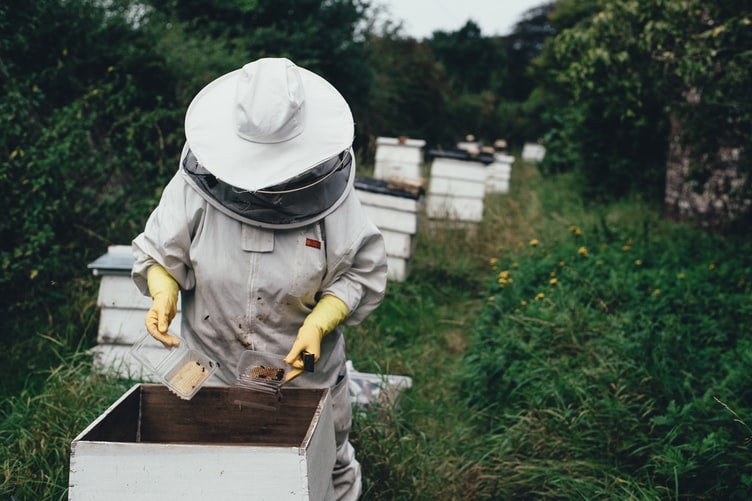Honeybees Continue to Vanish: Don’t Blame Aliens — It’s Our Addiction to Pesticides That’s at Fault
By Evaggelos Vallianatos, TruthOut.org
Posted on April 16, 2009, Printed on April 21, 2009
When I was teaching at Humboldt State University in northern California 20 years ago, I invited a beekeeper to talk to my students. He said that each time he took his bees to southern California to pollinate other farmers’ crops, he would lose a third of his bees to sprays. In 2009, the loss ranges all the way to 60 percent.
Honeybees have been in terrible straits.

However, industrialized agriculture is not friendly to honeybees.
In 1974, the U.S. Environmental Protection Agency licensed the nerve gas parathion trapped into nylon bubbles the size of pollen particles.
What makes this microencapsulated formulation more dangerous to bees than the technical material is the very technology of the “time release” microcapsule.
This acutely toxic insecticide, born of chemical warfare, would be on the surface of the flower for several days. The foraging bee, if alive after its visit to the beautiful white flowers of almonds, for example, laden with invisible spheres of asphyxiating gas, would be bringing back to its home pollen and nectar mixed with parathion.
It is possible that the nectar, which the bee makes into honey, and the pollen, might end up in some food store to be bought and eaten by human beings.
Beekeepers are well aware of what is happening to their bees, including the potential that their honey may not be fit for humans.
Moreover, many beekeepers do not throw away the honey, pollen and wax of colonies destroyed by encapsulated parathion or other poisons. They melt the wax for new combs: And they sell both honey and pollen to the public.



No government agency listened to McGregor.
The result of America’s pesticide treadmill is that now, in 2009, honeybees and other pollinators are moving towards extinction.
In October 2006, the U.S. National Research Council warned of the” “demonstrably downward” trends in the populations of pollinators. For the first time since 1922, American farmers are renting imported bees for their crops. They are even buying bees from Australia.
Honeybees, the National Academies report said, pollinate more than 90 crops in America, but have declined by 30 percent in the last 20 years alone. The scientists who wrote the report expressed alarm at the precipitous decline of the pollinators.
Unfortunately, this made no difference to EPA, which failed to ban the microencapsulated parathion that is so deadly to honeybees.
Bee experts know that insecticides cause brain damage to the bees, disorienting them, making it often impossible for them to find their way home.
This is a consequence of decades of agribusiness warfare against nature and, in time, honeybees. In addition, beekeepers truck billions of bees all over the country for pollination, depriving them of good food, stressing them enormously, and, very possibly, injuring their health.
© 2009 TruthOut.org All rights reserved.
View this story online at: http://www.alternet.org/story/136827/

A little history explains this tragedy.
For millennia, honeybees lived in symbiotic relationship with societies all over the world.
The Greeks loved them. In the eighth century BCE, the epic poet Hesiod considered them gifts of the gods to just farmers. And in the fourth century of our era, the Greek mathematician Pappos admired their hexagonal cells, crediting them with “geometrical forethought.”



Government “regulators” know about this danger.
An academic expert, Carl Johansen, professor of entomology at Washington State University in Pullman, Washington, called the microencapsulated methyl parathion “the most destructive bee poisoning insecticide ever developed.”
In 1976, the U.S. Department of Agriculture published a report by one of its former employees, S. E. McGregor, a honeybee expert who documented that about a third of what we eat benefits from honeybee pollination. This includes vegetables, oilseeds and domesticated animals eating bee-pollinated hay.
In 2007, the value of food dependent on honeybees was $15 billion in the United States.
McGregor also pointed out that insect-pollinated legumes collect nitrogen from the air, storing it in their roots and enriching the soil. In addition, insect pollination makes the crops more wholesome and abundant. He advised the farmer he should never forget that “no cultural practice will cause fruit or seed to set if its pollination is neglected.”
In addition, McGregor blamed the chemical industry for seducing the farmers to its potent toxins. He said:
“[P]esticides are like dope drugs. The more they are used the more powerful the next one must be to give satisfaction” and therein develops the spiraling effect, the pesticide treadmill. The chemical salesman, in pressuring the grower to use his product, practically assumes the role of the “dope pusher.” Once the victim, the grower, is “hooked,” he becomes a steady and an ever-increasing user.


